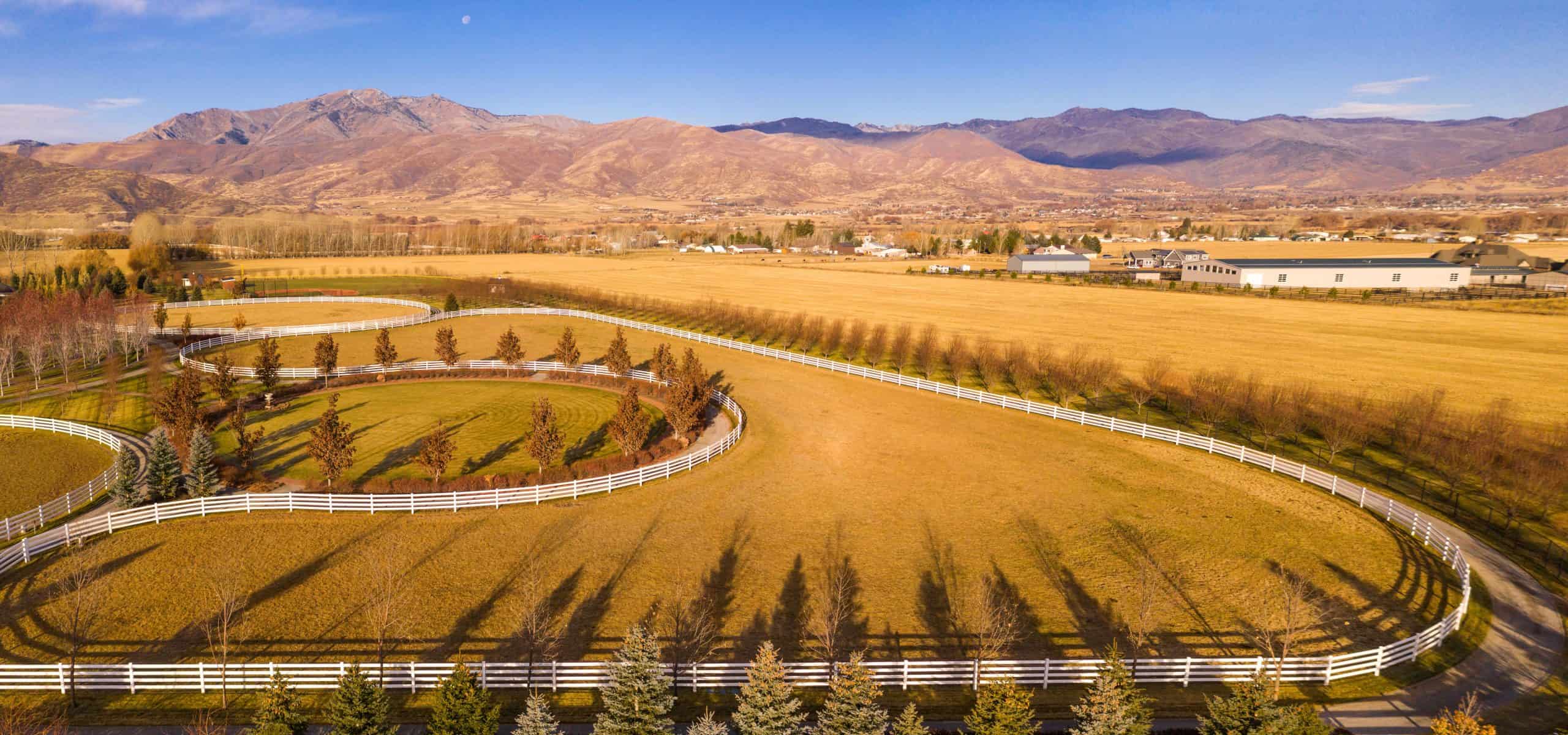Long fence runs amplify every material characteristic. The maintenance wood requires becomes overwhelming when you’re dealing with 2,000 feet instead of 200. The brittle failure vinyl experiences shows up repeatedly across large installations. The rust that starts small spreads relentlessly when you’ve got miles of metal fencing to monitor.
But long fences also change the economics. The material that makes sense for a small paddock might not pencil out for perimeter fencing. And the premium option that seems expensive per foot suddenly looks smart when you calculate total lifetime cost across large acreage.
The best material for long horse fences isn’t necessarily the best material for short runs. Below, we’ll break down what actually works when you’re fencing serious distance.
The Economics Behind Long Fences
Standard fencing math changes when you’re dealing with extensive runs.
A $5 per foot price difference seems minor on 100 feet—that’s $500. On 2,000 feet, it’s $10,000. Suddenly that difference demands serious consideration.
Still, consider wood fencing at $20 per foot that needs painting every 3-4 years and board replacement every 5-7 years. On 100 feet, that’s manageable weekend work. On 2,000 feet, you’re painting fence for weeks every few years and replacing hundreds of boards regularly.
The labor cost (whether your time or hired help) quickly exceeds the initial material savings.
Long fences also face different failure patterns. A single weak section in a 100-foot paddock gets noticed and fixed quickly. That same weakness across 2,000 feet might go undetected until your horses find it.
Material consistency matters more on long runs too. Wood fence looks beautiful when installed but weathers inconsistently, creating visual patchwork across long fence lines. Premium materials like our steel board fencing maintain consistent appearance across entire properties for decades.
Traditional Board Fencing at Scale
Rail fence options provide the classic look many horse property owners want, but material choice matters on long runs.
| Fence Type | Installed Cost (per ft) | Maintenance Costs | Lifespan | Total 20-Year Cost (2,000 ft) | Key Considerations |
| Wood Rail | $22–28 | Paint/stain every 3–4 yrs ($3–5/ft); replace 10–15% boards every 5–7 yrs ($8–12/board) | ~20 years | $60,000–80,000 | Classic look; high maintenance; degrades over time; good for small showcase areas |
| Vinyl Rail | $24–32 | Minimal routine care, but prone to UV/cold brittleness; color fading over time | 15–25 years | $48,000–64,000 (plus eventual replacement) | Low initial maintenance; inconsistent aging; brittle in cold or sun-heavy climates |
| Steel Board | $29–36 | Virtually none (no painting or board replacement) | 30–50+ years | $58,000–72,000 | Longest lifespan; consistent appearance; lowest lifetime cost; premium durability |
1. Wood Rail Fencing
Wood board fencing creates stunning visual impact that defines quality horse properties. The traditional aesthetic never goes out of style. But maintaining wood across 1,000+ feet transforms from weekend project to part-time job.
Calculate the real cost:
- Quality wood rail runs $22-28 per foot installed.
- Add painting/staining every 3-4 years at $3-5 per foot (materials and labor).
- Add board replacement—figure 10-15% of boards every 5-7 years at $8-12 per board.
Over twenty years on 2,000 feet of fencing, you’re looking at $60,000-80,000 total investment.
The maintenance time matters, too. Painting 2,000 feet of fence isn’t a weekend—it’s weeks of work. Most ranchers eventually let maintenance slip, and deteriorating wood fences actively detract from property value and appearance.
Wood works beautifully for featured areas, like around the main barn, along the driveway, in client-visible locations. Using premium wood in these showcase areas (maybe 20% of total fencing) while installing more practical materials for the bulk makes economic sense for many operations.
2. Vinyl Rail Fencing
Vinyl fence promises the board fence aesthetic without wood’s maintenance. At $24-32 per foot, it costs similar to wood initially while theoretically lasting 20-30 years maintenance-free. Sounds perfect for long fence runs until you examine the fine print.
Vinyl becomes brittle with UV exposure and temperature cycling. In northern climates, cold winters make vinyl increasingly fragile—impacts that would merely scratch steel or dent wood shatter aged vinyl completely. Sun-intense southern climates accelerate UV degradation. Both conditions guarantee eventual brittleness across long installations.
The failure pattern creates headaches on long fence runs. Vinyl doesn’t gradually degrade like wood, either. It seems fine until suddenly it’s not. Sections that looked solid yesterday shatter today because brittleness reached the tipping point. When that happens across 1,500 feet instead of 150, replacement becomes major project rather than minor repair.
Vinyl also suffers from aesthetic inconsistency over time. Sections age differently based on sun exposure, creating visible color variations across long fence runs. What started as pristine white becomes patchwork of slightly different shades.
3. Steel Board Fencing
Our steel board system was engineered specifically for applications where long-term performance across extensive installations matters more than minimal upfront cost.
At $29-36 per foot installed, steel board initially costs more than wood or basic wire options. But examine the total economics:
- Zero painting
- Minimal maintenance
- 30-50 year lifespan
That 2,000-foot perimeter costs $58,000-72,000 installed and requires virtually nothing beyond quarterly inspections for three decades or more.
Compare that to wood’s $60,000-80,000 twenty-year cost, or vinyl that needs complete replacement after 15-20 years. Steel delivers lower lifetime cost while providing superior safety and consistent appearance throughout its lifespan.
The engineering matters for long fence runs. Our boards flex under impact rather than shattering or splintering. The galvanization plus powder coating system resists rust indefinitely, and that’s a gamechanger when you’re monitoring hundreds or thousands of feet.
Visual consistency across long runs sets steel apart. Every section looks identical from day one through year thirty. No weathering variations, no patchy repairs, no gradual deterioration that signals deferred maintenance.
Hybrid Approaches for Cost-Conscious Ranchers
Smart material allocation stretches budgets without compromising critical areas.
- Premium Perimeter, Practical Interior: Install top-quality steel board fencing for visible perimeter and high-traffic areas where horses congregate. Use economical no-climb mesh for interior divisions and remote pasture sections. This strategy puts premium materials where they deliver maximum visual impact and safety benefit.
- Phased Installation: Fence critical areas first with quality materials, then expand as budget allows. Installing 500 feet of proper fencing annually beats installing 2,000 feet of inadequate fencing all at once. This approach prevents the false economy of replacing failed budget fencing repeatedly.
- Strategic Material Matching: For ranch fencing containing mixed livestock, use horse-appropriate materials in equine areas while employing more economical solutions for cattle-only sections. Horses demand superior fencing—cattle are more forgiving of basic wire systems.
Review our guidance on 3 vs 4 rail configurations to optimize board count for different applications. Strategic rail selection balances containment security with material costs across long runs.
Installation Considerations for Long Fence Runs
Proper installation maximizes any material’s performance across extensive distances.
- Post Spacing: Calculate fence post requirements carefully based on terrain and material choice. Stretching spacing beyond recommendations to save money creates weak points that compromise the entire run. Our steel board specifications detail proper spacing for maximum performance.
- Terrain Adaptation: Long fence runs inevitably cross varied terrain. Proper installation techniques for following land contours prevent gaps and weak points. Our installation videos demonstrate adapting to hills, valleys, and grade changes without compromising security.
- Property Line Awareness: Understand how close to property lines you can build before starting long fence runs. Discovering setback violations after installing 1,000 feet creates expensive problems. Verify boundaries and requirements first.
- Professional vs. DIY: Long fence runs challenge even experienced DIYers. Complex installations or challenging terrain often justify professional installation that ensures proper alignment, tensioning, and post setting across extensive distances. Poor installation compromises even premium materials.
Fence Your Property Right
Long horse fences represent major investment in your property’s functionality and value. The material you choose today determines whether you’re maintaining beautiful, safe boundaries decades from now or constantly fighting deterioration, escape attempts, and mounting repair costs.
We’ve engineered our steel board fencing specifically for demanding applications where performance matters more than minimal upfront cost. Every installation proves what proper materials deliver across hundreds or thousands of feet: safety, durability, and appearance that lasts.
Contact us to discuss your specific needs and get accurate pricing for your long fence project. Let’s build something that protects your horses and your investment for generations.
Frequently Asked Questions
Q. What’s the most economical material for fencing large horse properties?
High-tensile wire offers lowest per-foot cost at $8-15 installed, but safety concerns and maintenance requirements reduce its value for horse applications. No-climb mesh with steel top rail at $20-25 per foot balances economy with appropriate horse safety for extensive perimeter fencing.
Q. How much does it cost to fence 5 acres for horses?
Five acres requires roughly 1,900 linear feet of perimeter fencing (assuming square property). Costs range from $15,000-28,000 for basic wire systems, $42,000-54,000 for wood rail, $45,000-60,000 for vinyl, and $55,000-68,000 for steel board fencing. Steel’s higher initial cost delivers lower lifetime expense through minimal maintenance.
Q. Can I mix materials to reduce costs on long fence runs?
Yes, strategically. Use premium materials like steel board for visible perimeters, high-traffic areas, and anywhere horses regularly interact with fencing. Employ more economical no-climb mesh for remote pasture sections and interior divisions. Maintain visual consistency in client-visible areas.
Q. What material requires least maintenance across long distances?
Steel board fencing requires only quarterly inspections and occasional hardware tightening across any distance. Wood demands extensive painting, board replacement, and constant monitoring. Wire systems need regular tension adjustment and connection checks. Vinyl requires no routine maintenance but eventually needs complete replacement.
Q. Should I install long horse fencing myself or hire professionals?
Complex terrain, extensive distance, or lack of heavy equipment typically justify professional installation. Proper post depth, alignment, and material tensioning become increasingly critical across long runs where mistakes multiply. DIY works for experienced ranchers with appropriate equipment on straightforward, level terrain.



